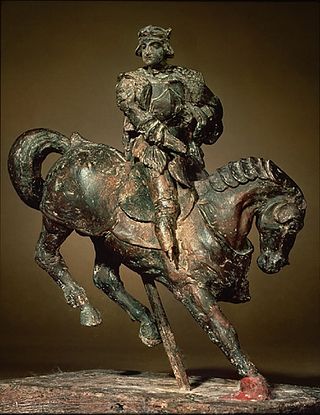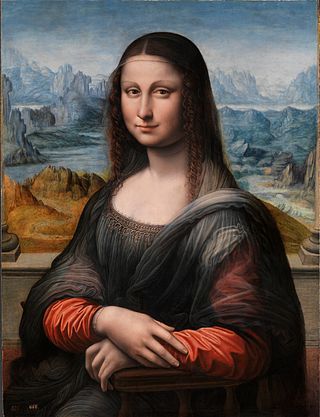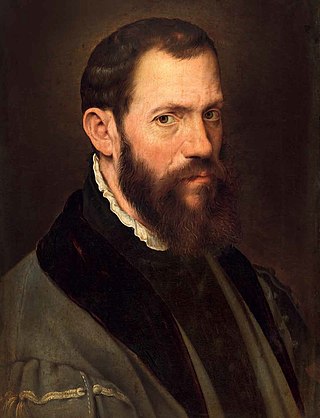Pompeo Leoni | |
|---|---|
 | |
| Born | Early 1530s Milan |
| Died | October, 1608 Madrid |
| Occupation(s) | Sculptor, medallist, art collector. |
Pompei Leoni was an Italian sculptor and medalist who was born in Milan in the early 1530s [1] and died in Madrid in October 1608.
Pompeo Leoni | |
|---|---|
 | |
| Born | Early 1530s Milan |
| Died | October, 1608 Madrid |
| Occupation(s) | Sculptor, medallist, art collector. |
Pompei Leoni was an Italian sculptor and medalist who was born in Milan in the early 1530s [1] and died in Madrid in October 1608.
Pompeo learned the art of sculpture and medal making in the house of his father, Leone Leoni, in Milan, called the Casa degli Omenoni, where he had set up a school [2] .

In addition to his Milanese customers, Pompeo, like his father, worked mainly for the Spanish monarchy. In particular, he collaborated with the sculptors Jacopo Nizzola, Bautista Comane, and Juan Bautista Monegro on the construction of the Escorial. Most of his sculptures are preserved in Spain [3] .

At his father's request, he amassed an important art collection. In his Trattato dell'arte de la pittura, published in 1584, Giovanni Paolo Lomazzo states that two mythological paintings by Correggio, Jupiter et Io and Danaë (now in the Kunsthistorisches Museum in Vienna and the Galleria Borghese in Rome, [4] respectively), sent by Pompey from Lombardy, Spain, were preserved in the Leoni household in Milan. It is not known whether he received the works from the sovereign himself or whether he bought them from his favorite Antonio Perez after his disgrace in 1579.
In 1589, he came into possession of the notebooks, manuscripts, and drawings that Leonardo da Vinci had bequeathed to his pupil Francesco Melzi. When this latter died in 1570, his son Orazio Melzi distributed the manuscripts; he sold some and gave others to friends and collectors. Pompeo Leoni received some from Melzi and bought others.
In 1630, Antonio Mazenta wrote about the distribution of Leonardo's manuscripts, accusing Pompeo Leoni of being one of the main culprits and of having altered their order. To distinguish between artistic and technical or scientific drawings, Leoni dismantled the original manuscripts and created two separate collections: the first, Disegni di Machine e delle Arti Secreti et Altre Cose di Leonardo da Vinci Racolti da Pompeo Leoni, grouped scientific and technical drawings, this is the Codex Atlanticus kept at the Biblioteca Ambrosiana in Milan. The second, Disegni di Leonardo da Vinci restaurati da Pompeo Leoni, was intended to group botanical and anatomical drawings; it has been dismantled and the sheets can be found in several European collections, [5] such as the Codex Windsor in the Royal Collection of Windsor Castle since the 17th century, [6] and the Codex Madrid in the National Library of Spain.




Leonardo di ser Piero da Vinci was an Italian polymath of the High Renaissance who was active as a painter, draughtsman, engineer, scientist, theorist, sculptor, and architect. While his fame initially rested on his achievements as a painter, he has also become known for his notebooks, in which he made drawings and notes on a variety of subjects, including anatomy, astronomy, botany, cartography, painting, and paleontology. Leonardo is widely regarded to have been a genius who epitomized the Renaissance humanist ideal, and his collective works comprise a contribution to later generations of artists matched only by that of his younger contemporary Michelangelo.

The Vitruvian Man is a drawing by the Italian Renaissance artist and scientist Leonardo da Vinci, dated to c. 1490. Inspired by the writings of the ancient Roman architect Vitruvius, the drawing depicts a nude man in two superimposed positions with his arms and legs apart and inscribed in both a circle and square. It was described by the art historian Carmen C. Bambach as "justly ranked among the all-time iconic images of Western civilization". Although not the only known drawing of a man inspired by the writings of Vitruvius, the work is a unique synthesis of artistic and scientific ideals and often considered an archetypal representation of the High Renaissance.

Francesco Melzi, or Francesco de Melzi (1491–1567), was an Italian painter born into a family of the Milanese nobility in Lombardy. He became a pupil of Leonardo da Vinci and remained as his closest professional assistant throughout his career. After da Vinci's death he became the literary executor of all da Vinci's papers, editing them into a manuscript on painting he published as Tratatto della Pittura [Treatise on Painting] or a compilation entitled the Codex Urbinas.
Giovanni Magenta was an Italian architect. He designed the cathedral of San Pietro at Bologna (1605). It was later modified by Alfonso Torreggiani (1765). He designed the church of San Salvatore in Bologna (1605–1623) and San Paolo.

Leone Leoni was an Italian sculptor of international outlook who travelled in Italy, Germany, Austria, France, Spain and the Netherlands. Leoni is regarded as the finest of the Cinquecento medallists. He made his reputation in commissions he received from the Habsburg monarchs Charles V, Holy Roman Emperor and Philip II of Spain. His usual medium was bronze, although he also worked in marble and alabaster, carved gemstones and probably left some finished work in wax, as well as designing coins. He mainly produced portraits, and was repeatedly used by the Spanish, and also the Austrian, Habsburgs.

The Codex Atlanticus is a 12-volume, bound set of drawings and writings by Leonardo da Vinci, the largest single set. Its name indicates the large paper used to preserve original Leonardo notebook pages, which was used for atlases. It comprises 1,119 leaves dating from 1478 to 1519, the contents covering a great variety of subjects, from flight to weaponry to musical instruments and from mathematics to botany. This codex was gathered in the late 16th century by the sculptor Pompeo Leoni, who dismembered some of Leonardo's notebooks in its formation. It is now in the Biblioteca Ambrosiana in Milan.

Commentary on the Apocalypse is a book written in the eighth century by the Spanish monk and theologian Beatus of Liébana (730–785) and copied and illustrated in manuscript in works called "Beati" during the 10th and 11th centuries AD. It is a commentary on the New Testament Apocalypse of John or Book of Revelation. It also refers to any manuscript copy of this work, especially any of the 27 illuminated copies that have survived. It is often referred to simply as the Beatus. The historical significance of the Commentary is made even more pronounced since it included a world map, which offers a rare insight into the geographical understanding of the post-Roman world. Well-known copies include the Morgan, the Saint-Sever, the Gerona, the Osma and the Madrid Beatus codices.

A Treatise on Painting is a collection of Leonardo da Vinci's writings entered in his notebooks under the general heading "On Painting". The manuscripts were begun in Milan while Leonardo was under the service of Ludovico Sforza and gathered together by his heir Francesco Melzi. An abridged version of the treatise was first published in France in 1651. After Melzi's manuscript was rediscovered in the Vatican Library, the treatise was published in its modern form in 1817.

Casa degli Omenoni is a historic palace of Milan, northern Italy, located in the eponymous street of Via degli Omenoni. It was designed by sculptor Leone Leoni for himself; he both lived and worked there. It owes its name to the eight atlantes decorating its facade, termed "omenoni", which were sculpted by Antonio Abondio, most probably on a design by Leoni. Lions are a recurring theme of its decorations; in particular, a large relief placed under the cornice depicts two lions tearing a satyr into pieces. The overall style of the palace and the decorations have been noted to include several references to the art of Michelangelo. The internal courtyard, modified in 1929 by Piero Portaluppi, has a colonnade with metopes and triglyphs.

Gian Giacomo Caprotti da Oreno, better known as Salaì was an Italian artist and pupil of Leonardo da Vinci from 1490 to 1518. Salaì entered Leonardo's household at the age of ten. He created paintings under the name of Andrea Salaì. He was described as one of Leonardo's students and lifelong companion and servant and was the model for Leonardo's St. John the Baptist, Bacchus and Angelo incarnato.

The Madrid Codices I–II, are two manuscripts by Leonardo da Vinci which were discovered in the Biblioteca Nacional de España in Madrid in 1965 by Dr. Jules Piccus, Language Professor at the University of Massachusetts. The Madrid Codices I was finished during 1490 and 1499, and II from 1503 to 1505.

The Leonardeschi were the large group of artists who worked in the studio of, or under the influence of, Leonardo da Vinci. They were artists of Italian Renaissance painting, although his influence extended to many countries within Europe.

Horse and Rider is a beeswax sculpture depicting a rider on a horse. The history of the sculpture is unknown before the 20th century. The work has been attributed to Leonardo da Vinci by the Italian art historian Carlo Pedretti, though most historians have ignored or denied the attribution. A number of casts have been made, using a mold taken from the wax original.

Studies of the Fetus in the Womb are two coloured annotated sketches by Leonardo da Vinci made in around 1511. The studies correctly depict the human fetus in its proper position inside a dissected uterus. Leonardo depicted the uterus with one chamber, in contrast to theories that the uterus had multiple chambers which many believed divided fetuses into separate compartments in the case of twins. Leonardo also correctly drew the uterine artery and the vascular system of the cervix and vagina.

The Prado Mona Lisa is a painting by the workshop of Leonardo da Vinci and depicts the same subject and composition as Leonardo's better known Mona Lisa at the Louvre, Paris. The Prado Mona Lisa has been in the collection of the Museo del Prado in Madrid, Spain since 1819, but was considered for decades a relatively unimportant copy. Following its restoration in 2012, however, the Prado's Mona Lisa has come to be understood as the earliest known studio copy of Leonardo's masterpiece.

The Rearing Horse and Mounted Warrior or Budapest horse is a bronze sculpture attributed to Leonardo da Vinci. Depicting Francis I of France on a destrier horse, it is estimated to have been cast from a clay or wax model in the first half of the 16th century. The sculpture is in the permanent exhibit of the Budapest Museum of Fine Arts.
Augusto Marinoni was professor of romance philology at the Università Cattolica del Sacro Cuore of Milan, a member of the Commissione Vinciana and the Accademia dei Lincei. He is considered one of the greatest scholars of Leonardo da Vinci.

Jacopo da Trezzo was an Italian Renaissance sculptor of medals and jeweller, who after beginning his career in Milan moved to employment by the Spanish Habsburgs in 1554. He spent the rest of his career working for the Spanish court, beginning by visiting England in 1554–55 during the marriage of Philip II of Spain and Mary I of England, which lasted from 1554 to her death in 1558.

The Study for the Virgin's Right Arm is a drawing by the Florentine painter Leonardo da Vinci that is kept at Windsor Castle in the United Kingdom. It is drawn in charcoal or black stone, gray chalk, ink, and white gouache highlights on red-tinted paper.

{{cite book}}: CS1 maint: DOI inactive as of April 2024 (link)